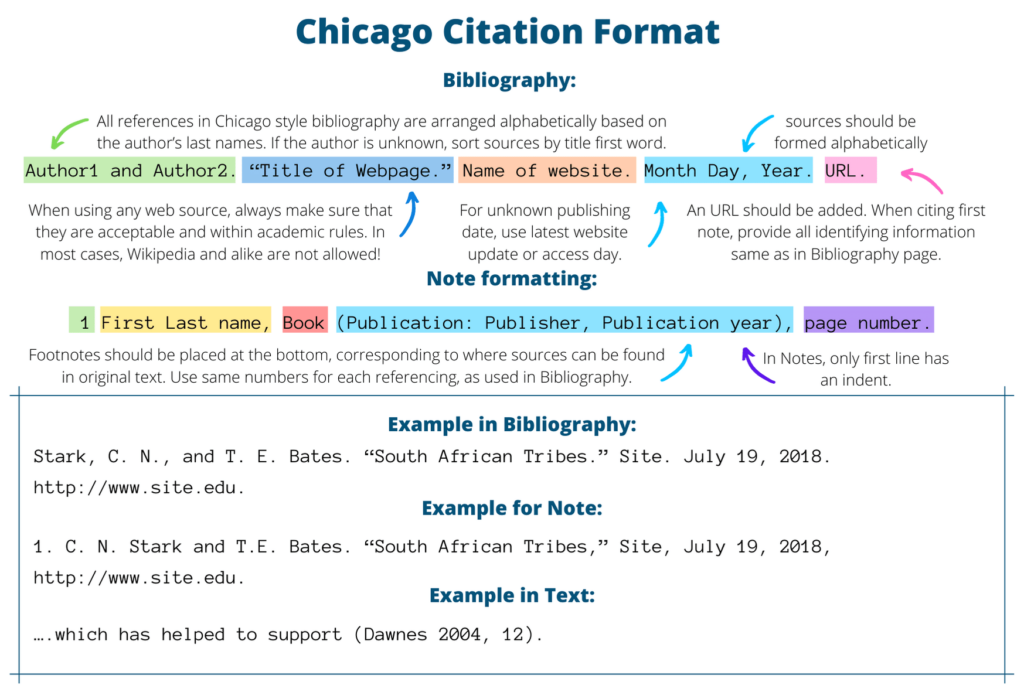
CHICAGO CITATION
Chicago citation style is widely used in the humanities, particularly in history and social sciences. It provides two primary systems for citing sources: the Notes and Bibliography system and the Author-Date system. The system you use depends on the subject matter and the requirements of your work or instructor.
1. Notes and Bibliography System
This system is often preferred in the humanities, especially in history. It uses footnotes or endnotes, along with a bibliography. Citations are presented in the form of superscript numbers that correspond to footnotes at the bottom of the page or endnotes at the end of the paper.
Footnote/Endnote Citation:
- In the notes, each source is cited in full the first time it appears. Subsequent citations can use a shortened form.
Example of First Citation in a Footnote/Endnote (Book):
- John Smith, History of Ancient Civilizations (New York: Random House, 2020), 45.
Subsequent Citations (Shortened Form): 2. Smith, History of Ancient Civilizations, 47.
Example of First Citation in a Footnote/Endnote (Journal Article):
- Emily Brown, "The Rise of Social Media Influence," Journal of Modern Studies 12, no. 2 (2019): 23, https://doi.org/10.1234/jms.2020.002.
Bibliography:
The bibliography lists all the sources cited in your paper, arranged alphabetically by the author's last name. Entries in the bibliography are similar to the first full note but with slight changes in format. The first author's last name appears first, followed by their first name.
Example of a Book in the Bibliography: Smith, John. History of Ancient Civilizations. New York: Random House, 2020.
Example of a Journal Article in the Bibliography: Brown, Emily. "The Rise of Social Media Influence." Journal of Modern Studies 12, no. 2 (2019): 21–30. https://doi.org/10.1234/jms.2020.002.
2. Author-Date System
The Author-Date system is more common in the social sciences. It uses parenthetical in-text citations that include the author's last name, publication year, and, if relevant, the page number. These correspond to full references in the reference list at the end of the paper.
In-Text Citations:
The citation appears in parentheses within the text and includes the author’s last name and the publication year, followed by the page number if applicable.
Example of In-Text Citation (Book): (Smith 2020, 45)
Example of In-Text Citation (Journal Article): (Brown 2019, 23)
Reference List:
Entries in the reference list include the full details of the cited sources. They are alphabetically arranged by the author's last name and follow a similar structure to the bibliography in the notes system, but without the reverse order of the author’s name.
Example of a Book in the Reference List: Smith, John. 2020. History of Ancient Civilizations. New York: Random House.
Example of a Journal Article in the Reference List: Brown, Emily. 2019. "The Rise of Social Media Influence." Journal of Modern Studies 12 (2): 21–30. https://doi.org/10.1234/jms.2020.002.
3. Key Features of Chicago Style:
- Footnotes/Endnotes (Notes and Bibliography System): Used for providing full references or brief explanations, footnotes and endnotes are numbered sequentially and correspond to superscript numbers within the text.
- Parenthetical Citations (Author-Date System): Used in-text to briefly reference sources, these are enclosed in parentheses and correspond to full references in a list at the end of the document.
- Bibliography/Reference List: At the end of the document, a bibliography or reference list includes full citations of all sources cited, ordered alphabetically.
4. Examples for Different Types of Sources:
Books:
-
Notes/Footnote (First Citation):
- John Smith, The Evolution of Technology (New York: Harper Collins, 2015), 120.
-
Shortened Notes/Footnote (Subsequent Citation):
2. Smith, The Evolution of Technology, 121. -
Bibliography Entry:
Smith, John. The Evolution of Technology. New York: Harper Collins, 2015.
Journal Articles:
-
Notes/Footnote (First Citation):
- Emily Brown, "The Psychology of Social Media," Journal of Social Psychology 14, no. 3 (2020): 43, https://doi.org/10.5678/jsp.2020.345.
-
Shortened Notes/Footnote (Subsequent Citation):
2. Brown, "The Psychology of Social Media," 45. -
Bibliography Entry:
Brown, Emily. "The Psychology of Social Media." Journal of Social Psychology 14, no. 3 (2020): 40-55. https://doi.org/10.5678/jsp.2020.345.
Websites:
- Notes/Footnote (First Citation):
- Patricia Johnson, "The Impact of Climate Change on Agriculture," The Green Blog, April 10, 2020, https://www.greenblog.com/climate-change-agriculture.
- Bibliography Entry:
Johnson, Patricia. "The Impact of Climate Change on Agriculture." The Green Blog, April 10, 2020. https://www.greenblog.com/climate-change-agriculture.
5. Why Use Chicago Citation?
The Chicago Manual of Style is valued for its flexibility, allowing scholars to format their work according to the specific needs of their discipline. The Notes and Bibliography system is ideal for subjects where detailed, discursive notes are helpful, such as history and literature. The Author-Date system is preferred in fields that emphasize brevity and quick reference, like the sciences and social sciences.
Both systems prioritize clarity, consistency, and proper acknowledgment of sources, ensuring that writers give credit to original ideas and research. This not only enhances the writer’s credibility but also allows readers to follow up on sources easily.